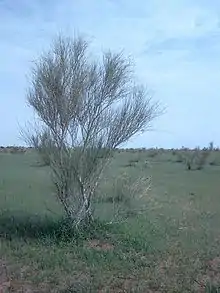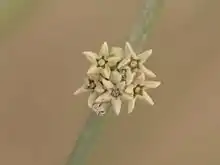Leptadenia pyrotechnica
Leptadenia pyrotechnica (Hindi: खींप; Punjabi: ਖਿੱਪ) is the botanical name of a desert herb of the family Apocynaceae. It is widespread from Senegal to India.[1] It is known as khimp in Hindi and Urdu,"Khipp" in Punjabi.[2]
| Leptadenia pyrotechnica | |
|---|---|
 | |
| Scientific classification | |
| Kingdom: | Plantae |
| Clade: | Tracheophytes |
| Clade: | Angiosperms |
| Clade: | Eudicots |
| Clade: | Asterids |
| Order: | Gentianales |
| Family: | Apocynaceae |
| Genus: | Leptadenia |
| Species: | L. pyrotechnica |
| Binomial name | |
| Leptadenia pyrotechnica | |
Being highly drought-resistant, Leptadenia pyrotechnica has played an important role in the desert afforestation programs. The herb khimp is a strong soil binder and, as such, is one of the pioneer species in sand dune fixation.[2]
Description
Leptadenia pyrotechnica is heavily branched and reaches heights of up to 3 metres. The shrub's long roots reach up to 12 metres below the surface.[3] The leaves of the green to grey-green branches tend to fall off early. When present, they are opposite, sessile, elongated to linear, glabrous and about 2 cm long and 3 mm wide.
The very small, greenish-yellow, hermaphrodite and five-fold, short-stalked flowers with a double inflorescence have a diameter of 2 mm and stand in axillary, small zymous inflorescences. The flowers are fine-haired and have a minimal, fleshy corolla. The two ovaries are on top, whilst the stigma and stamens are fused into a very short gynostegium.
The narrow and bare, many-seeded, green, bean-shaped fruits are up to 8–11 cm long.[4]
Uses
.JPG.webp)
The plant is used in thatching huts. The pods of this shrub, known as khimpoli (खींपोळी) in Hindi, ripe in the month of March which are of medicinal value and used as vegetables. The plant fiber is used for making ropes. The plant is browsed by all stock, but especially by camels for which it is considered a good fodder.
Gallery
 Leptadenia pyrotechnica pods
Leptadenia pyrotechnica pods Leptadenia pyrotechnica pods
Leptadenia pyrotechnica pods Leptadenia pyrotechnica flower
Leptadenia pyrotechnica flower
References
- Flora of Pakistan, Leptadenia pyrotechnica (Forssk.) Decne. in Ann. Sci. Nat. Ser. 2. 9:269. 1839. Boiss., Fl. Or. 4:63.1879; Bullock in Hutch., Dalziel & Hepper, Fl. W. Trop. Afr. ed. 2.2:98. 1963; Rech. f., Fl. Iran. 73: 16.1970.
- L. R. Burdak (1982): Recent advances in desert afforestation, Dehradun, p.66
- K. H. Batanouny, A. M. Abdel Wahab: Eco-Physiological Studies on Desert Plants: VIII. Root Penetration of Leptadenia pyrotechnica (Forsk.) Decne. in Relation to Its Water Balance. In: Oeeologia (Berl.) 11, 1973, S. 151–161, doi:10.1007/BF00345129.
- M. Arbonnier: Arbres, arbustes et lianes des zones seches d'Afrique de l'Ouest. CIRAD, Montpellier 2000, ISBN 2-87614-431-X.